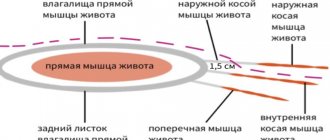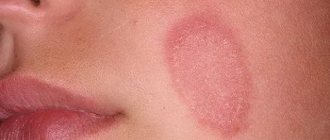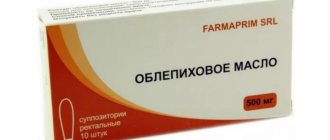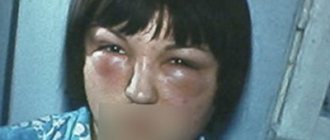Surgeon, coloproctologist
Skorkina
Irina Konstantinovna
14 years of experience
Doctor of the highest category, member of the European Society of Surgeons
Make an appointment Hemorrhoids are a common serious disease during which the internal venous nodes of the rectal plexus become inflamed and enlarged. In addition, very often everything is accompanied by bleeding. If you pay attention to worldwide statistics, literally every seventh person on our planet sooner or later begins to suffer from hemorrhoids. Not every person will seek help at the hospital or recognize hemorrhoids on their own, because they have many symptoms. If we make an assumption, it is likely that a quarter of the population of our planet suffers from hemorrhoids, so this disease must be dealt with by turning to professional specialists.
Rectal diseases seem unacceptable to people to talk about, but this is all a stereotype that needs to be fought. Untreated hemorrhoids can lead to other problems. Then the cost of treating hemorrhoids will be much higher. Very often, people turn to the clinic for help at an advanced stage. In this case, fighting the disease is much more difficult. It is important to note that gender does not matter. Both women and men can suffer from the disease, so it must be taken seriously.
Absolutely anyone can get hemorrhoids, but there are some aspects that are worth paying attention to. The disease mainly affects people who lead a mostly sedentary lifestyle or who engage in anal sex too often. The disease is also affected by a person’s daily diet. If he is fond of smoked, spicy, too salty foods, then he has a much greater chance of getting hemorrhoids. But even if a person is very keen on sports or works in a hard job, then he too can catch this type of disease and need the best treatment for hemorrhoids.
Typology of hemorrhoids
Doctors identify several of the most common types and stages in the treatment of hemorrhoids, which all patients go through. Hemorrhoids are a serious problem that needs to be dealt with so that the situation does not become too advanced, and a professional clinic will help with this. You need to know what it is and about these common stages and types of hemorrhoids. Main classification of hemorrhoids:
- Chronic. This is perhaps the most common type. Many professionals and doctors discover the occurrence of chronic hemorrhoids in their patients. Very often, people go to the hospital with discomfort around the anus, slight itching, or even complaints of bleeding. It is important to note that this disease does not appear out of nowhere. It can develop for a couple of months or even a couple of years, and only then make itself felt. During the development of the disease, the patient does not experience absolutely anything, so he does not even think about contacting a specialist to get tested; there are no first signs of hemorrhoids. When the next stage of chronic hemorrhoids arrives, everything begins to hurt, bleeding becomes frequent, there is a predisposition to itching, and everything rapidly worsens.
- Spicy. This is a continuation of chronic hemorrhoids, or rather its complication, which can only be accurately identified only by a professional examination in a clinic. Very often at this stage a person begins to suffer from thrombosis, very severe pain and the sensation of some kind of foreign body inside himself. Body temperature also increases, but these are all general first signs and types. Only a specialist can tell you more about everything and offer effective treatment for hemorrhoids. You can cure acute hemorrhoids if you contact the best professionals; the cost of treating hemorrhoids is not too high.
- Interior. Hemorrhoids can also be internal. In this case we are talking about varicose veins of the rectum and anus. At first, no problems in the intestines are detected, so there is no thought that hemorrhoids need to be treated. If you do not seek help in time, internal hemorrhoids can cause dangerous complications. So people can develop vein thrombosis - the first sign - due to the fact that the blood stagnated all the time during hemorrhoids. Also, nodules can constantly fall out, but this is only if internal hemorrhoids reach the fourth stage. In addition, due to constant bleeding, the patient may develop anemia, headache, and the anal valve may weaken, causing incontinence. To cure internal hemorrhoids, you need to go to the hospital and apply modern best treatment principles, the price of which is affordable.
- Outer. External hemorrhoids are a serious problem that requires special treatment. External hemorrhoids are called and diagnosed as cavity formations, which in turn are completely filled with venous blood. The dilated vessels in the anal area form something very similar to a lump, which develops over three stages. Very often, when the form is advanced, complications also arise: the corpora cavernosa begin to become inflamed, venous thrombosis actively develops, and then surgery is necessary.
What are hemorrhoids
Many examinations show that the main type of disease is a lump. If hemorrhoids come out, then it is accompanied and characterized, firstly, by veins falling out of the anus. If we talk about color, the bumps can be of different colors depending on what stage of the disease the patient is at. If you do not perform surgery, or do not use any modern method of treatment, then the lump will grow more and more over time, and the inflammation will also increase. An advanced form of hemorrhoids can acquire a burgundy or even bluish tint, or give rise to other types, which is why there is no need to hesitate and you should urgently consult a doctor. Most often, in the fight against hemorrhoids, a simple professional operation is performed - this is the best effective solution.
Diagnosis of hemorrhoids: determining the cause and symptoms in men and women
Common symptoms of hemorrhoids include itching, pain, rectal fullness or hardness, and bleeding. Diagnosis is made based on a history and physical examination. The history may indicate associated symptoms, including constipation, problems with bowel movements, and straining to go to the toilet. Your doctor will ask more questions to look for other causes of rectal bleeding, including tumors, inflammatory bowel disease, and gastrointestinal bleeding.
To confirm the diagnosis, determine the cause of hemorrhoids and select treatment, an examination is performed. It involves a rectal examination, in which a finger is used to feel for abnormal lumps or masses. A rectal examination may be delayed if pain or swelling is severe. Additionally, hemorrhoids and constipation may be associated with anal fissures in the skin surrounding the anus. The associated pain and spasm makes rectal examination very painful. If the doctor is concerned that symptoms, especially rectal bleeding, cannot be explained by hemorrhoids, an anoscopy may be considered. This is a procedure in which a lighted tube is inserted to view the anus. If there is concern that bleeding is coming from other areas of the colon, a sigmoidoscopy or colonoscopy may be performed. These procedures are usually performed by a gastroenterologist or surgeon.
Depending on the situation, blood tests may be ordered. If there was heavy bleeding, you need to check your hemoglobin or red blood cell levels. If the patient is taking blood thinners, a coagulation test is necessary.
Symptoms, signs of hemorrhoids
Professional doctors distinguish various symptoms of hemorrhoids, since there are different stages and manifestations of the disease, but there are the most common signs that are worth paying attention to.
So, the most obvious elements that will help identify hemorrhoids are frequent bleeding and prolapse of nodes. Constant itching of the anus or unbearable pain, especially if the hemorrhoids have already come out and are in the second stage. People suffering from hemorrhoids complain of constant signs of hemorrhoids - swelling of the anus and mucus that comes out of it. In most cases, hemorrhoids develop over time and do not manifest themselves in one day, so the symptoms of hemorrhoids also appear gradually. During this disease, a foreign body is felt in the anus, there seems to be a feeling of some kind of heaviness - this is the first sign.
If hemorrhoids are only at the initial stage, then the main sign of the disease can only be recognized during constipation or intestinal upset or after severe physical exertion. There are cases when the disease manifests itself completely suddenly, produces symptoms, and then testing is simply necessary. If drug treatment for hemorrhoids does not work, then surgery is needed.
Read more about the main symptoms of hemorrhoids
The most common symptoms of hemorrhoids are bleeding in the anus and prolapse of hemorrhoids.
So let's start with the first one. This symptom is clearly expressed by scarlet blood, which is released during defecation or after it has passed. Blood is released as dripping individual drops that can be seen directly in the stool or on pieces of toilet paper. As for the intensity of this symptom, it may vary. Thus, a patient with hemorrhoids may detect only a few imperceptible drops of blood or very copious discharge. Hemorrhoids, or rather their loss, are the second most common symptom of the disease. At first, they move into the anal canal on their own, but in the later stages of hemorrhoids they constantly fall out. The patient feels constant pain and discomfort, which is why it is recommended to immediately contact one of the clinics and undergo a full examination. Hemorrhoids are very often characterized by constant dull pain during a long stage of development of the disease, which is reinforced by additional exacerbations. Pain is especially felt during acute thrombosis or anal fissure and is one of the proven symptoms.
In the anus, a symptom of hemorrhoids such as anal itching is often felt in any of the types. This happens because the nodes are constantly falling out, the skin of the anal area is irritated, so it is recommended to go and get checked by a doctor to determine the types. Perianal edema is also possible, which often characterizes acute signs of hemorrhoids and its symptoms, since chronic hemorrhoids rarely show such a sign. But it is best to check any aspect to make sure what the patient is dealing with and how the disease is progressing. This symptom occurs as a constant feeling of discomfort, heaviness in the perineum in the anus; if it exists, you need to consult a doctor. In many cases, surgery helps get rid of hemorrhoids.
All this is associated with hemorrhoids, constant prolapse of nodes and a number of other symptoms, for example, mucus secretion. This is a pathology during which a kind of mucus comes out of the rectum. In this situation, professional treatment in a clinic, possible surgery and the necessary tests are required. Another common and main symptom of hemorrhoids is thrombosis of the hemorrhoids, which cannot be effectively treated on your own. In general, it is possible to treat hemorrhoids, but for this you need to make an effort, get tested, have hemorrhoids removed and seek specialized help, since there are different types of the disease. To remove hemorrhoids, you need to go to the hospital.
Are you experiencing symptoms of hemorrhoids?
Only a doctor can accurately diagnose the disease. Don't delay your consultation - call
Surgery for hemorrhoids
Many of us lead a sedentary lifestyle, which is greatly facilitated by working in an office. We rarely think about the fact that lack of mobility can lead to such an unpleasant illness as hemorrhoids.
According to all-knowing statistics, a quarter of the adult population of our planet suffers from hemorrhoids in various forms. You don't want to be included in this number, do you? Analyze whether you are at risk. You are at risk if you have a sedentary lifestyle and do not have time to exercise. Let's together try to understand in more detail what hemorrhoids are, what is their prevention and what is the treatment of hemorrhoids.
Symptoms of hemorrhoids
Hemorrhoids can develop for many reasons. Here are the main reasons that can lead to the development of hemorrhoids:
- Poor nutrition (abuse of fatty, spicy foods)
- Alcohol abuse
- Excess weight
- Excessive physical activity, which may increase intra-abdominal pressure
- Prolonged diarrhea
- Anal sex
Hemorrhoids do not appear suddenly, they begin in stages. One of the first signs that doctors recommend paying attention to is the occurrence of mild itching in the anus. After some time, the itching will be accompanied by pain when defecating. These symptoms may be present in the patient for many years without causing him too much concern. Evidence that hemorrhoids have entered the acute stage is the detection of drops of blood in the stool.
Our recommendation: if you find blood in your stool, you should immediately consult a proctologist. Treatment of hemorrhoids should begin as early as possible! Blood in the stool may indicate not only an exacerbation of hemorrhoids, but also possible malignant formations in the intestines.
The appearance of drops of blood during bowel movements is only the initial stage of the disease, then hemorrhoids will begin to prolapse.
What is a hemorrhoid?
Proctologists distinguish four stages of development of this disease. Treatment of hemorrhoids is determined by its stage. It is formed because the veins in the anus begin to swell and expand. Hemorrhoids are varicose veins of the rectum. Due to the indicated reasons (excess weight, poor diet, constipation, etc.), a violation of the venous outflow occurs, as a result of which a hemorrhoidal node is formed. Hemorrhoidal bleeding occurs due to inflammation and thinning of the walls of the nodes. The walls of the nodes often become inflamed; it should be remembered that the anus is a delicate place, and feces irritate the walls. As a result of irritation, the hemorrhoid begins to bleed.
- In the first phase of the disease, the patient experiences pain before and after defecation and periodic bleeding.
- In the second stage of the disease, hemorrhoidal nodes that emerge when the abdominal muscles are tense are added to the bleeding that occurs. At this stage of the disease, the nodes move into place on their own.
- At the third stage, hemorrhoids fall out after each bowel movement. Adjusted only with the help of hands. With further development of the disease, the nodes fall out with every lifting of weights and even with a strong cough.
- When the disease reaches the fourth stage, hemorrhoids fall out even in a calm state and fall out almost immediately after the node is set in place. Frequent severe bleeding begins, and thrombosis develops rapidly.
Diagnosis of hemorrhoids
Proctologists diagnose hemorrhoids in three main ways: they perform a digital examination, anoscopy and sigmoidoscopy.
When conducting a digital examination, the proctologist carefully inserts a finger into the anus and palpates the rectum, trying to assess how much its walls are stretched. Next, the proctologist examines the contents of the rectum - the presence of blood, pus, feces, mucus, etc. After a digital examination, the proctologist performs an anoscopy.
The patient is given a cleansing enema (microlax), after cleaning the rectum, an anoscope is inserted into the anus to a depth of 6-8 cm. An anoscope is a small special device, with its help the proctologist examines the patient’s rectum. Anoscopy can detect polyps, malignant neoplasms, fissures and hemorrhoids.
Treatment of hemorrhoids
Sigmoidoscopy is considered a more accurate and modern type of rectal diagnosis. This method makes it possible to examine the rectum with a length of 25-30 cm from the anus. The rectoscope is equipped with a special optical device that can be used to detect any, even the most minor, changes occurring in the patient’s rectum. The next step after establishing an accurate diagnosis is to follow all the recommendations of the attending physician; he will select an individual hemorrhoid treatment regimen for the patient.
You can begin treatment for hemorrhoids at any phase of the disease, but it is still better not to delay seeing a doctor, because the sooner the sufferer turns to a proctologist for help, the more successful and easy the treatment will be.
The acute stage of hemorrhoids can occur suddenly, for example, from sudden lifting of weights or from a violation of the diet. At this stage, treatment of hemorrhoids is aimed at relieving acute manifestations of the disease (thrombosis, bleeding, inflammation, etc.). After the disappearance of acute symptoms, the patient is advised to refrain from lifting heavy objects, strenuous exercise, and be sure to follow the diet recommended by the proctologist.
In cases where hemorrhoids become chronic and remission is often followed by unexpected acute exacerbations, several hemorrhoid treatment methods may be prescribed. In the initial stages of the disease (stage 1-2), when the patient suffers from an unpleasant burning sensation in the anus and minor bleeding, the proctologist will prescribe medication for hemorrhoids. If the disease is not neglected and treatment is started on time, follow the doctor’s recommendations (take prescribed medications, avoid fatty and spicy foods, lead an active lifestyle, try not to sit too long, do not lift heavy objects with sudden jerks, do not engage in anal sex), then these tips will help the patient increase the intervals between exacerbations of the disease. To reduce pain, a variety of gels, ointments and special medicinal suppositories are prescribed. If the pain is unbearable, the doctor will perform a medical anesthesia of the anus - several injections of a modern anesthetic are made into the tissue near the anus.
In the treatment of hemorrhoids, one cannot do without drugs that prevent thrombosis, bleeding, relieve pain and inflammation. To prevent these symptoms, a proctologist may recommend suppositories and ointments: Ultraproct, Anuzol, Hepatrombin, Proctosedyl, Proctoglivenol, Proctosan, etc. These medications relieve pain and relieve inflammation, dissolve blood clots, strengthen the walls of hemorrhoidal vessels and prevent the exacerbation of the disease.
To achieve an effective result, the treatment of hemorrhoids must be comprehensive, combining the use of several drugs aimed at eliminating pain, stopping bleeding, and improving the health of the veins.
In cases where long-term drug treatment of hemorrhoids has not brought results, it is necessary to move on to other methods of treating hemorrhoids.
Minimally invasive methods for treating hemorrhoids
The patient is given a small cleansing enema. Then the doctor takes a ligator, onto the working part of which a latex ring is put. The hemorrhoidal node is pulled into the ligator, the ring is put on the base of the node and tightened. After about 2-3 days, the hemorrhoidal node falls off along with the latex ring. In its place there remains a wound that quickly heals on its own. In one session, only 1-2 rings can be placed, and if the patient has 3 or more hemorrhoids, then after 2-4 weeks the procedure for ligating the hemorrhoids has to be repeated. This step-by-step treatment of hemorrhoids can take up to 1-2 months. The advantages of the method of ligation of hemorrhoids are: low pain and low trauma, bloodlessness, without the need for general anesthesia, hospitalization and interruption of the patient’s professional activity. These methods make it possible to cure hemorrhoids of stages 1-3. By applying latex rings, hemorrhoids are eliminated.
As a method of choice, for hemorrhoids of stages 1-2, sclerotherapy is sometimes performed - a solution of ethoxysclerol is injected into the hemorrhoid, which causes emptying, gluing and sclerosis of the hemorrhoid. This method is used when drug treatment is not effective. After sclerotherapy, doctors recommend following the recommendations: reduce physical activity, stick to a diet, and do not sit for too long.
Modern minimally invasive technologies such as disarterization of hemorrhoids under Doppler ultrasound control (HAL-RAR) and destruction of hemorrhoids using laser have significantly reduced the trauma and pain of operations, shortened the postoperative recovery period and improved the results of hemorrhoid treatment. Our experience has shown that when combining HAL-RAR methods and destruction of hemorrhoids using a laser, it is possible to obtain good results in the treatment of stage 3 and 4 hemorrhoids in a low-traumatic manner, with a short recovery period.
Hemorrhoidectomy
This is the removal of hemorrhoids through surgery.
Hemorrhoidectomy is used for advanced hemorrhoids (stages 3 and 4). Using a scalpel, scissors, and electrocoagulation, hemorrhoids are removed. The use of modern technologies, Ligasure, ultrasonic scissors, reduced the trauma and operation time. This operation is performed under general or spinal anesthesia for 30-60 minutes.
At the site of the removed node, several small wounds are formed, which subsequently heal with the help of conservative therapy (rectal suppositories, ointments, baths). In addition, painkillers and laxatives are prescribed to normalize stools and facilitate bowel movements after surgery.
The positive outcome of the operation has been observed for several years. But if you do not adhere to medical recommendations, hemorrhoids may begin to develop again.
Only a proctologist can figure out which treatment method is right for the patient.
Prevention of hemorrhoids
To prevent hemorrhoids from developing, perform water procedures more often. Taking a warm bath improves blood microcirculation. We must not forget about personal hygiene after defecation. It is necessary not only to use multi-layer toilet paper, but also to wash with cool water. Long-term constipation can lead to the formation of anal fissures, which can develop into hemorrhoids. Diarrhea is no less dangerous than constipation - there is a disturbance in the intestinal microflora, as a result of which an infection can be introduced into the walls of the colon. Doctors advise following a balanced diet, carefully monitoring your stool, and periodically taking medications that help normalize the intestinal microflora.
To prevent the development of hemorrhoids, doctors advise not to strain during bowel movements. The fact is that increased muscle tension can also lead to bleeding and the development of cracks. You also need to beware of hypothermia - it can cause exacerbation and development of acute hemorrhoids.
People who have already encountered problems with hemorrhoids should always adhere to a balanced diet and exclude spicy foods and alcoholic drinks from their diet. Alcohol and excessive consumption of spices increase blood flow to the anus, and this can lead to severe bleeding. Hemorrhoids are considered an occupational disease of drivers. So for those who spend a lot of time driving, we recommend taking breaks more often and not neglecting physical exercise.
You should not self-medicate - as soon as you suspect that you are starting to develop hemorrhoids, you should immediately consult a specialist. Only a proctologist will be able to reliably establish a diagnosis and determine what kind of hemorrhoid treatment is necessary for you.
You can make an appointment with a doctor by phone, through an online appointment or in a mobile application.
Diagnosis of hemorrhoids
If hemorrhoids come out, then it is imperative to visit a doctor, seek treatment for hemorrhoids at the hospital and conduct a diagnosis for the presence of diseases.
In fact, the diagnosis of this disease is quite simple, but it is important to take the treatment itself very seriously. If the hospital does not carry out all the necessary tests, then it is likely that the doctor will make an incorrect diagnosis. Insufficient testing of the patient and omission of analysis leads to the fact that significant complications or pathologies that may follow the development of hemorrhoids are not detected. During the diagnosis of hemorrhoids, the doctor examines the patient in a special gynecological chair, which allows you to identify hemorrhoids of the anus and select an effective treatment regimen for hemorrhoids. The doctor must look at what is happening in the patient’s intestines and what the anus looks like, if hemorrhoids appear, and prescribe treatment. When all the initial tests have been passed by the patient, the doctor must quickly examine the stool, analysis, color and condition of the skin, and the presence of a gap in the anus. He must also monitor the presence of scar changes, hemorrhoids, and make a diagnosis.
An analysis of the frequency of prolapse of nodes and diseases is required; the doctor draws conclusions on the diagnosis, whether it is necessary to undergo surgery, removal of hemorrhoids, or use a treatment method. It is possible to fight this disease if you find the right approach during diagnosis, but this requires a highly accurate diagnosis. The medical institution uses only the most modern and innovative equipment, thanks to which effective research is carried out, accurate diagnoses are made quickly, and cures are attempted.
Most often, it is very difficult to diagnose the correct location and size of the nodes if the entire examination is carried out using the finger method, all this due to the fact that during palpation the nodes become much smaller. That is why during the study the patient must constantly interact with doctors and get tested. This is the only way they will diagnose the exact type of hemorrhoids, because an accurate overview of the area where the nodes are located will be given and a treatment method will be chosen.
If a doctor diagnoses a suspicion of hemorrhoids, he will necessarily perform a sigmoidoscopy. In case of illness, this analysis effectively allows you to determine hemorrhoids or exclude various additional diseases, especially those related to the intestines. For hemorrhoids, during diagnosis, the doctor may prescribe a gastroscopy to exclude bleeding from a part of the digestive system and cure it.
As practice shows, with a correct diagnostic review, doctors detect the appearance of anal canal diseases that contribute to hemorrhoids. The large intestine may also be affected. Many of them cause frequent bleeding in the anus.
In some cases, doctors say that patients suffer from rectal cancer. Therefore, if there are any strange sensations in the intestines or the intestinal problem has been diagnosed for a long time, you need to become a frequent visitor to medical clinics. You need to visit a doctor and find a treatment method, effective techniques, and perform an operation. A clinic that will offer innovative treatment methods will help residents of Moscow cure hemorrhoids.
Content
- Inspection stages
- Basic methods of examination by a proctologist
As surprising as it may seem in our time, some of my patients are afraid of being examined by a proctologist. True, after it is carried out, all those who are afraid are surprised that the examination is painless and claim that they were afraid in vain.
Let's get rid of such fears and take care of the most precious thing we have - our health. This article is for you and your friends.
So, you came to the proctologist for an appointment. You have already prepared (the administrator talks about this stage in detail).
The beginning began - a conversation with the doctor. Without any embarrassment, tell us about your illness as you imagine it, preferably in detail. The doctor will clarify those details that are most important in diagnosing the disease and building a picture of the patient’s health. The doctor will write down the most important details in the outpatient card. Then, having signed consent for examination (as it should be in the modern world), the patient goes to the treatment room.
There he will be met by a nurse - a doctor's assistant - and will tell him how to prepare directly for the examination. At this stage, the patient undresses; you can wear special disposable underwear. The nurse will then help the patient lie down correctly on the examination table to make the examination as comfortable as possible. A position is taken on the left side, similar to a fetal position. This position is aesthetically most acceptable for examination and is comfortable for both the patient and the doctor conducting the examination.
Causes of hemorrhoids
The main reason for the appearance of hemorrhoids in a patient is the moment when the veins of the rectum become overstretched due to the fact that blood is stuck in the pelvis.
In this case, it is necessary to remove the hemorrhoids. All people are prone to such stagnation of blood, so it should be noted that the disease is common. Common causes of problems in the anus are high blood pressure and blood clots. This reason interferes with the free passage of feces or, on the contrary, clogs everything in the anus. Causes of hemorrhoids:
- use of grandmother's methods of treatment;
- menstruation;
- abuse of anal sex;
- excessive anal hygiene;
- increased consumption of spicy, salty, fatty foods, which stimulate the colon;
- frequent horse riding, bicycle riding;
- pregnancy;
- passive lifestyle.
It is important to note that problems in the anus can also be due to heredity. Then a certain scheme is used to treat the disease. There are different treatment methods, because each case has its own scheme, which is selected by the proctologist. When removing hemorrhoids, you will need to adhere to some rules, but you need to decide which scheme is effective. The cause of hemorrhoids may be a congenital insufficiency of the structure of the veins. In this case, periodic prophylaxis and a special indication are recommended. There are many causes of hemorrhoids. These often include oral contraceptives and enemas, but even riding a motorcycle can be one of the reasons, so you can’t do this often.
How to determine external and internal hemorrhoids
Normal hemorrhoidal tissue is not visible because it must first swell and become inflamed or form a clot to cause symptoms. Swollen external hemorrhoids or internal prolapsed hemorrhoids outside the anus may be seen, but internal hemorrhoids are not visible because the nodes remain inside the anus. A thrombosed hemorrhoid will appear as a lump on the edge of the anus protruding from the anus and will be dark bluish in color due to the clot contained within the swollen blood vessel. A nonthrombosed hemorrhoid will appear as a lump of skin. Often several swollen hemorrhoids appear at the same time.
Treatment of hemorrhoids
In general, hemorrhoids are treated by a specialist called a proctologist.
Therefore, if you urgently go to the clinic, you need to look for it. This doctor treats hemorrhoids comprehensively, according to a specially developed individual scheme. It is impossible to say exactly how much treatment for hemorrhoids costs, since each type has its own prices for treatment to remove hemorrhoids. A professional proctologist first identifies the cause of the disease. If the problem is constipation, then he tries to improve the functioning of the stomach using a set of treatment methods. If the reason is a sedentary lifestyle, then the doctor will use physical therapy methods and eradicate this cause and give his testimony. If hemorrhoids started due to stress, then the proctologist will think about how to treat the psyche, whether any of the methods are effective, and will give a list of contraindications. There are different methods of treating hemorrhoids, as they come from the causes, the doctors of the clinic offer modern treatment for any hemorrhoids and innovative methods of treatment. Now they offer to use special equipment, a developed treatment regimen for hemorrhoids, methods for removing hemorrhoids, and drug treatment if surgery is not possible. Each hemorrhoid treatment regimen is developed individually and this is the task of the clinic’s proctologist.
Stages of hemorrhoids
Hemorrhoids can be acute (when the disease develops rapidly and is accompanied by severe pain and discomfort) and chronic. In the second case, a mild pain syndrome is observed, the disease develops over a long period of time with periods of exacerbation (bleeding, prolapse and pinched nodes occur).
First stage
Mild discomfort is felt, and short-term bleeding is typical, which occurs after any overexertion - hard work, defecation. Inflammation is detected only during examination. At this stage, conservative treatment, sclerotherapy, and photocoagulation are recommended.
Second stage
It is characterized by periodic prolapse of inflamed hemorrhoids, while bleeding may be absent. The dropped nodes are set on their own without much effort. Conservative treatment, sclerotherapy, photocoagulation, ligation, or a combination of these techniques is recommended.
Third stage
Dystrophic changes occur in the sphincter, it weakens, as a result of which prolapsed hemorrhoids can only be set manually. The course of the disease is accompanied by severe itching, frequent and heavy bleeding. Ligation, surgical treatment, and a combination of techniques are recommended.
Fourth stage
Hemorrhoids are in a constantly prolapsed state along with the rectal mucosa. It is impossible to set them. It may be accompanied by bleeding or occur without it. Inflammation can affect nearby tissues. Surgery to remove hemorrhoids is indicated.
Methods for treating hemorrhoids
If you consult a doctor in a timely manner, you can very quickly return to your previous life and forget about all your problems forever.
The easiest way to recover at an early stage is to take painkillers, anti-inflammatory drugs, and anti-blood clot medications specifically prescribed by the doctor to stop bleeding. Here it is important to take a certain dose at a specifically prescribed time. A specialist will tell you about this and how much the treatment costs. The disease can be cured by pathogenetic therapy, which normalizes digestion and eliminates constipation with the help of a special diet and enzyme preparations. In addition, you can try symptomatic therapy, which should improve venous tone.
Antithrombosis therapy is also actively used in many clinics. During treatment, doctors prescribe a special heparin ointment. If an acute disease is detected, doctors use combination therapy.
The most effective modern method of treating hemorrhoids is surgery, but it is used only in advanced forms of the last stages of the disease. If earlier this method was considered the main one in the treatment of hemorrhoids, now doctors are actively using the minimally invasive method and other modern, more patient-friendly options.
What are internal and external hemorrhoids
Internal hemorrhoids are located above the pectineal line and are covered with the same cells as those lining the rest of the intestine. External hemorrhoids occur below the line and are covered with skin-like cells.
Outer
Externally it manifests itself as hemorrhoids outside the anus. They are located near the sphincter. The nodes become inflamed and enlarge due to stagnation of blood in the pelvic area. If a blood clot appears in the external node, swelling forms, causing pain to the person. The patient feels a voluminous lump on sensitive thin skin. This development of the disease is typical with an incorrect diet, stagnation of blood in the rectum, low physical activity, and heavy physical exertion. When the skin that covers the node becomes thinner, a blood clot comes out, followed by bleeding.
Interior
With this form, hemorrhoids are almost invisible. They are located inside the anal canal, in the place where it passes into the rectum, under the mucous membrane. The nodes appear due to the protrusion of blood vessels and are usually painless. However, even in this case, hemorrhoidal thrombosis may occur. At an early stage, the disease can be recognized by a small amount of blood discharge after bowel movements.
Doctors treating this disease
People who suffer from hemorrhoids and do not understand doctors often wonder which doctor treats their disease.
A specialist such as a proctologist deals with the professional treatment of hemorrhoids. Therefore, you should consult a doctor if hemorrhoids actively progress. It treats all diseases related to the perineum, colon, rectum and colon. The doctor diagnoses the possible development of diseases, prescribes prevention, gives a list of indications, and tells the approximate cost of treatment. The task of a proctologist is to cure perineal disease, polyps, and anal fissures. Every proctologist knows what not to do for hemorrhoids. He is professional in his work and is always ready to remove hemorrhoids. This doctor treats an individual patient's hemorrhoids. That is why you need to look at the list of doctors in order to decide on the necessary treating professional who will cure hemorrhoids in the clinic.
Why are hemorrhoids dangerous?
The most common complications of hemorrhoids are inflammation, thrombosis or bleeding. It is important to remember that rectal bleeding or blood in the stool is always abnormal, and although it can be caused by a relatively benign cause (such as hemorrhoids), other, more serious causes can be life-threatening. These include bleeding from ulcers, diverticulitis, inflammatory bowel disease and tumors. This is especially important if a person is taking blood thinners.
Contraindications
There are a number of contraindications that absolutely all doctors put forward during the course of treatment for hemorrhoids, so when you go to the clinic to treat hemorrhoids, you should pay special attention to this.
It is best to take into account each contraindication in the early stages of the disease. This will actively speed up treatment and, in principle, make it easier. By contacting a proctologist who treats diseases specifically related to the perineum, the patient will immediately receive an important contraindication. The first contraindication for hemorrhoids is refusal to lift weights. Excessive physical exertion can increase the pressure in the veins, causing blood flow to be delayed. If the patient has previously been involved in sports, then he needs to switch to more gentle training, reduce the weight load and the number of exercises. Another contraindication for hemorrhoids is that it is not recommended to wear tight underwear and tight outerwear. It is not recommended to engage in horse riding for people who have definitely been diagnosed with hemorrhoids. Another common contraindication for hemorrhoids is that you should never use soap or shower gels, as this can cause the skin to become even more inflamed. In this case, you need to use only natural soap with low alkali levels, otherwise the symptoms of hemorrhoids will become even higher. Doctors actively talk about what you should not do if hemorrhoids develop - eat fatty foods, since obesity can also cause the development of the disease.
Prevention of hemorrhoids
Prevention is the most effective treatment. Diet and adequate fluid intake are very important to maintain normal bowel movements. Symptoms of hemorrhoids can occur with the passage of hard stools and constipation, as well as with diarrhea and frequent bowel movements. People with constipation may need a high-fiber diet, adequate fluids, and stool softeners. Those who have excessively frequent bowel movements may need antidiarrheal medications and dietary adjustments. These preventive measures reduce the strain required to have a bowel movement, thereby reducing the pressure in the blood vessels to prevent swelling.
The SM-Clinic Surgery Center provides services for prompt diagnosis and effective treatment of hemorrhoids using non-surgical methods and surgical techniques. Our patients recover within 24 hours in a comfortable hospital setting and quickly return to their normal lifestyle. Other treatment methods are also used, depending on the stage and type of disease. Advanced equipment is used for diagnostics, ensuring accuracy and speed of obtaining results.
Postoperative period
Rehabilitation after removal of hemorrhoids is the most important stage in the patient’s life. After any operation, efforts should be made to prevent complications and accelerate tissue healing. In the postoperative period, we prescribe a protective regime, a strict diet and certain medications.
The following rules must be observed:
- hunger on the first day after surgery (drinking liquids is allowed);
- a diet that excludes foods with a gas-forming effect - prohibited: black bread, legumes, milk, cabbage;
- It is forbidden to eat pickled foods, pickles, spices;
- alcohol is excluded;
- the diet is enriched with fermented milk products, it is recommended to consume a large volume of liquid - at least 1.5-2 liters per day;
- heavy physical labor is limited for at least 3 weeks after surgery;
- careful personal hygiene is required.
If coloproctological diseases occur, contact the Federal Scientific and Clinical Center of the Federal Medical and Biological Agency of Russia in Moscow - we will help solve any health problems.
How to prepare for hemorrhoid surgery
Preoperative examination includes an examination by a doctor and a number of laboratory and instrumental examinations, among which the following are mandatory:
- blood and urine tests (general);
- biochemical blood test;
- coagulogram;
- determination of blood group and Rh factor;
- blood test for antibodies to HIV and hepatitis viruses.
A few days before the planned date of surgery, the patient should adhere to a special diet with a minimum of foods that stimulate peristalsis. On the eve of the operation and 2-3 hours before it, you should do a cleansing enema. You should definitely tell your doctor if you are taking any medications; you should evaluate the possibility of taking them during and after surgery.









